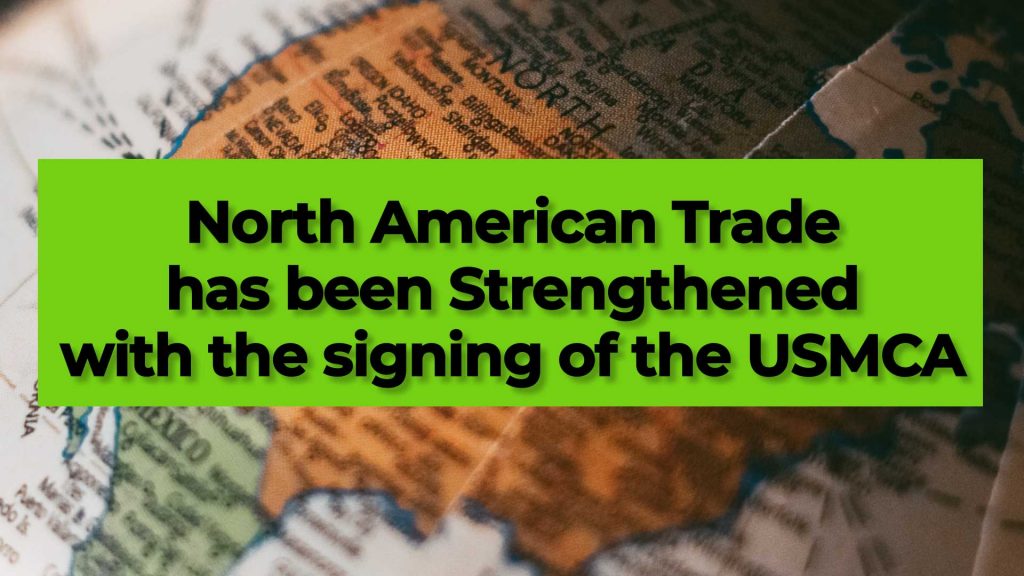2020 was one of the toughest years in over a decade for supply chain and business managers globally. While the ongoing COVID-19 pandemic has been the main challenge, there have been other headlines throughout the year that hugely affected the supply chain industry globally.
USMCA
The passing of the USMCA agreement was a widely praised move to update much of the NAFTA language and let it evolve further to take into account tech advancements among other items. USMCA is generally seen as a positive step from NAFTA, strengthening the trade bond between the US, Mexico, and Canada, and will no doubt result in more trade than ever between member nations. Some firms already are planning to move production from China to Mexico, as a way to nearshore their manufacturing footprint.
Overtime no doubt the language of the USMCA will be updated but it provides a strong basis for trade and takes into account digital intellectual property which the original NAFTA agreement was lacking on.

COVID19
The obvious headline from the year was the widespread coronavirus pandemic that has affected nearly every business in some way on a global scale. With vendors, suppliers, customer base and demand, transportation and logistics partners all affected in different ways, supply chain managers have had a very tough time adapting as quickly as possible to the altered landscape. For many firms, this has meant working with suppliers to try to prevent inventory shortages and maintain at least some level of production. Also the pressure on firms to make sure that operations are continued while teams work from home and safety protocols are in place for employees that must work on-premise. With spot outbreaks in warehouses and factories, quick thinking and agility have been key for companies to keep operations running as smoothly as possible.
Consumer demand and peak season
Following the spread of coronavirus, many retailers and transportation providers were simply not ready for the quick rebound in consumer demand that started in the summer of 2020. This put many firms in a rush to book ocean, air, and trucking capacity as rates rapidly rose from previous levels.
Spot market rates in particular heavily increased and have remained highly elevated through the end of 2020. Most predict rates will remain high at least until March/April of 2021, as demand for restocking inventory remains high.
California AB5 / Prop 22
California’s AB5 regulation focused on making many independent contractors full-time employees, while aimed at the tech industry, current owner operator trucking and drayage firms are thankfully exempt by the new law.
However there is a fear that future legislation could alter this, and there is currently an appeal in federal court that could possibly change the current exemption truck drivers have from AB5.
IF CDL owner-operators were not exempt, California supply chains would be disrupted with a lack of capacity. For trucking companies that already operate on thin margins, this presents a major potential challenge not only to transportation firms but also owner operators who are scrambling to find work, with many simply leaving California.
The high level outcome would be a decrease in trucking capacity and an increase in trucking rates within the state of California. Some firms have simply decided to not provide trucking services within the state following the passing.
Fortunately in early November, prop 22 won, which removed many Uber/Lyft style driving positions from the legal requirements of AB5. However, it’s unclear how the CDL truck driving industry will be affected by this change with many hoping AB5 will be continue to be inapplicable for CDL truck drivers. Regardless, going forward many companies are still wary of incoming or new regulations that could change it.
Maritime Emission Standards
Kicking off in January 2020, the global maritime shipping industry, which operates over 50,000 vessels, faced more stringent emission requirements industry-wide. While a positive step for the environment, there were strong concerns that increased fuel and implementation costs would be passed across the industry to consumers. While no doubt this has caused industry concern, the impact of COVID 19, with the initial drop in shipping demand followed by increases in demand overshadowed the effects of the IMO 2020 standards. The global demand drop for fuel oil also helped to curb the expected rise in fuel prices. Looking forward, it is very likely that shipping prices will trend up into 2021 as global oil consumption rises, increasing fuel prices.
From a technical viewpoint, the regulations reduced the amount of permissible sulfur output from heavy fuel oil-powered vessels. Keep in mind that the shipping industry consumes over 200 million gallons per day of fuel and that the heavy fuel oil that powers many ships contributes around 90% of annual sulfur emissions. Clearly, something had to be done, and the solution was either install scrubbers on ships, or switch to cleaner fuels such as VLSFO (very low sulfur fuel oil) or MGO (marine gas oil), both produce much fewer sulfur emissions than the HFO (heavy fuel oil). These alternative fuels however are more expensive and equipping scrubbers to ships is also an expensive proposition.

Brexit
As of Jan 1, 2021, the UK has officially left the EU. The process took over 4 years, with the threat of a “no–deal” Brexit a major concern until literally hours before, when a trade agreement was signed on the 31st.
While most economists and company leaders disagree that Brexit will be a positive move for the economy, the more immediate clear issue for business is the increase in uncertainty that it has brought over the last several years. Many firms held off on making major capital investments due to the potential for a no deal Brexit to heavily hurt the business.
Just adding to the drama of 2020, was the ongoing negotiations between EU and UK officials over what a would-be deal might or might not include with several deadlines having passed without any significant progress made. Thankfully the last-minute deal avoided what would have been an onerous tariff situation between UK and EU trading partners. This deal included provisions to avoid added tariffs on many products moving between the EU and UK. For UK manufacturing firms, such as niche car maker Aston Martin, this is a huge relief as added tariffs could have become a major financial issue for the firm.
Vaccine Logistics
With the FDA emergency approval and rollout of the Pfizer and Moderna Covid vaccines, the focus quickly shifted to how would these vaccines be distributed around the world. Supply Chain managers and firms quickly started to gear up to safely move the vaccine doses. The vaccines require freezing temperatures which puts the bulk of the transportation volume on traditional cold chain providers, while being augmented by other transportation and logistics firms. Airlines and parcel carriers such as USPS, UPS, FedEx and DHL are also playing a major part in the distribution of the COVID vaccines.
More Technology
2020 saw the development and release of more tech products and solutions within the industry than any prior year. The rise in transportation cost, work from home environment and general lack of trucking capacity in certain markets helped to push shippers to look at new capacity solutions. Visibility, shipment analytics, and online document management all favor digitally-enabled providers. The ease of shipping in this manner especially in a work from home situation makes adoption an easy choice.
Trade War?
The trade that started in 2018 with the then administration putting tariffs on Chinese goods to hopefully reduce the trade deficit, is still ongoing with little evidence of a resolution. The widespread economic belief is that evidence supports that overall the trade war has not been a positive step for the US economy, particularly for certain manufacturing firms that rely on Chinese goods, including steal and US farmers. The stated goal was also to revive US manufacturing, which has not materialized. One potentially positive step that was partially attributed to the added tariffs has been companies deciding to diversify their manufacturing reliance on China, but much of this production has shifted to Mexico or other Asian countries. The tariffs have not been the sole reason for this shift, which is important to note. The pandemic has large kept the trade war out of the media, but over time, likely a better resolution will hopefully be signed.
For Further Reading:
About Zmodal
Zmodal is a digitally enabled third-party multimodal logistics provider delivering intermodal, trucking and supply chain services via our own digital intermodal platform powered by our proprietary technology, all focused on giving you the service to make your company grow!



